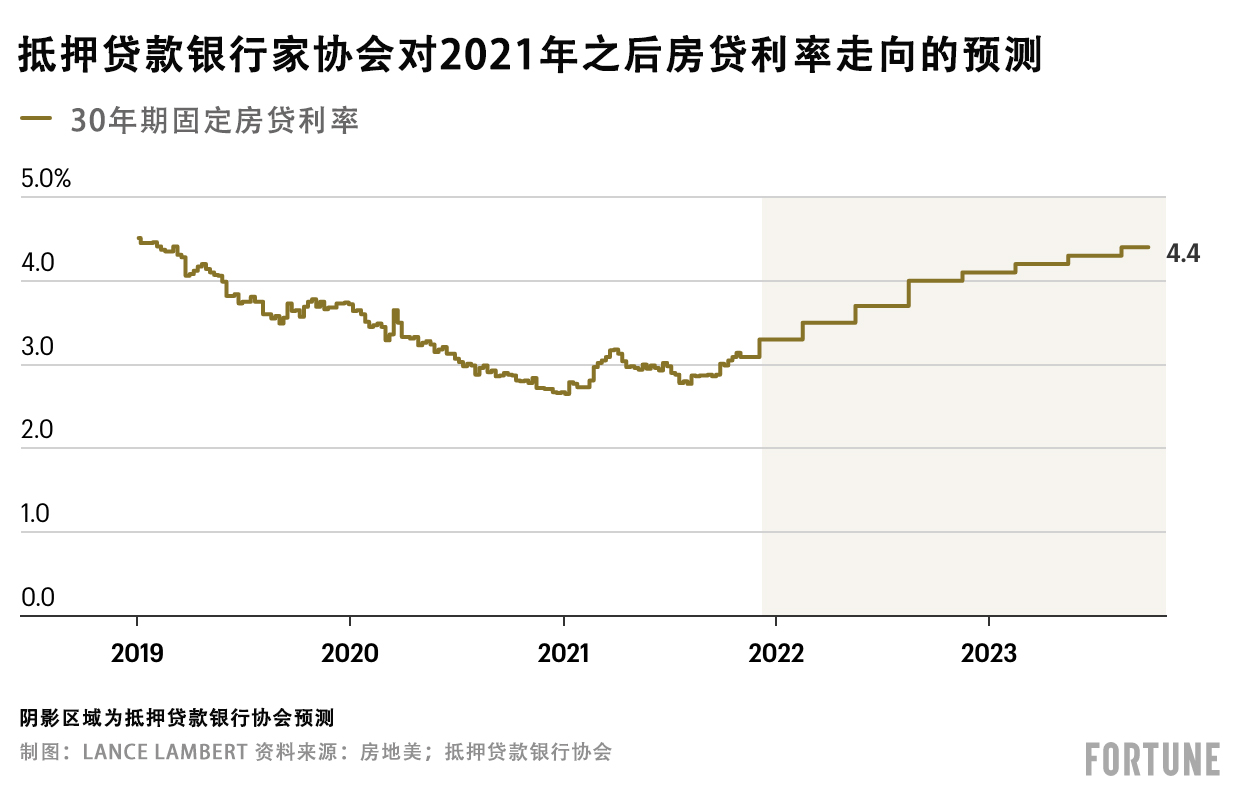美联储(Federal Reserve)官员去年夏天曾坚信,随着经济挺过由疫情引发的供需震荡,物价上涨现象将有望出现逆转。然而,有鉴于美国通胀数据最新创下39年新高,这一“昙花一现”的观点在本月基本上被人们抛之脑后。在该报告发布不久后,美联储主席杰罗米·鲍威尔表示,顽固的高通胀率意味着,背负着维持最大就业率和稳定物价这一双重国会任务的美国央行,更有可能“祭出加速缩债”的手段。
该声明引发了房地产行业的关注。如果美联储决定加息,并减少对抵押担保证券的购买,那么此举会导致房贷利率的上升。在疫情爆发的最初几周,美联储的举措使得抵押贷款利率降至历史最低水平,此举催生了现代史上最强势的房地产市场。然而,不断增长的房贷利率从理论上来讲会在2022年阻碍房地产市场的发展:它会为房价增速带来下行压力,因为一些买家会被市场拒之门外。
尽管如此,至于2022年利率会升至多高,房地产行业并没有一个统一的意见,更不用说不断上升的房贷利率会对如火如荼的房产市场带来多大的降温作用。房产市场的一些巨头预测,不断上升的利率多少会导致市场出现震荡现象,而其他人认为,房地产市场已足够强劲,即便贷款利率大涨也能消化。
认为利率上升会给市场带来些许震荡的阵营包括美国抵押贷款银行家协会(Mortgage Bankers Association)。总部位于华盛顿特区的该行业组织预测,30年期平均固定房贷利率(当前为3.1%)将在2022年底增至4%。该组织称,上述利率增幅有助于将现有房产明年的价格中值压低2.5%。这意味着去年房价19.5%的跃升会出现重大反转。

然而,并非所有机构都赞同抵押贷款银行家协会的预测,也不认同房贷利率的增长对于房价的影响。房利美(Fannie Mae)便是其中之一,它预测2022年底30年期平均房贷利率为3.3%。
抵押贷款银行家协会与房利美预测之间的差别可能要比乍看起来的更大。举个例子:如果一位借贷人以3.3%的利率借贷50万美元的30年期固定利率按揭贷款,那么其月供为2190美元。如果按照4%的利率计算,其月供将增至2387美元,也就是30年内多还70900美元。后者的还款额度将让更多的买家望而却步,同时还会让一些借款方失去抵押贷款资质,因为贷款发放依据的是严格的负债收入比。这也解释了为什么抵押贷款银行家协会的房贷利率预测与其明年房价将下滑2.5%的预测出奇的一致。正是因为这个原因,房利美在预测利率会温和上涨的同时还预测房价将在2022年继续增长7.9%,几乎是1980年以来房价平均涨幅(4.6%)的两倍。
即便房贷利率不会大幅增长,我们也不能理所当然地得出房价就会下滑的结论。Home.LLC首席执行官尼克·沙阿向《财富》杂志透露,他的公司同样预测房贷利率在2022年底将增至4%。Home.LLC是一家向购房者提供首付协助,并以此获得房屋未来转售利润分成权的初创企业。然而,与抵押贷款银行家协会不同的是,他指出,“[2022年]房价将继续上涨,只是增速会有所放缓。”
既然房贷利率从理论上来讲将出现大幅跃升,房价为何能够继续保持强劲的增长态势呢?沙阿提到了房产市场供需之间一直存在的失衡问题。我们当前正处于五年窗口期的中期阶段(2019年-2023年),于千禧一代出生人口最多的五年期间(1989年-1993年)降生的人群将在此时迎来其30岁生日,也就是最重要的首次购房年龄。与此同时,这些潜在的买家面临的是可售流通房屋处于40多年来最低水平的境况。总的来说,房地美(Freddie Mac)估计,美国当前可售房屋的数量与买家需求之间存在400万套的差距。受这一局势的影响,尽管房贷利率会有所增长,但房产市场在未来数年内依然是卖家的天下。(财富中文网)
译者:冯丰
审校:夏林
美联储(Federal Reserve)官员去年夏天曾坚信,随着经济挺过由疫情引发的供需震荡,物价上涨现象将有望出现逆转。然而,有鉴于美国通胀数据最新创下39年新高,这一“昙花一现”的观点在本月基本上被人们抛之脑后。在该报告发布不久后,美联储主席杰罗米·鲍威尔表示,顽固的高通胀率意味着,背负着维持最大就业率和稳定物价这一双重国会任务的美国央行,更有可能“祭出加速缩债”的手段。
该声明引发了房地产行业的关注。如果美联储决定加息,并减少对抵押担保证券的购买,那么此举会导致房贷利率的上升。在疫情爆发的最初几周,美联储的举措使得抵押贷款利率降至历史最低水平,此举催生了现代史上最强势的房地产市场。然而,不断增长的房贷利率从理论上来讲会在2022年阻碍房地产市场的发展:它会为房价增速带来下行压力,因为一些买家会被市场拒之门外。
尽管如此,至于2022年利率会升至多高,房地产行业并没有一个统一的意见,更不用说不断上升的房贷利率会对如火如荼的房产市场带来多大的降温作用。房产市场的一些巨头预测,不断上升的利率多少会导致市场出现震荡现象,而其他人认为,房地产市场已足够强劲,即便贷款利率大涨也能消化。
认为利率上升会给市场带来些许震荡的阵营包括美国抵押贷款银行家协会(Mortgage Bankers Association)。总部位于华盛顿特区的该行业组织预测,30年期平均固定房贷利率(当前为3.1%)将在2022年底增至4%。该组织称,上述利率增幅有助于将现有房产明年的价格中值压低2.5%。这意味着去年房价19.5%的跃升会出现重大反转。
然而,并非所有机构都赞同抵押贷款银行家协会的预测,也不认同房贷利率的增长对于房价的影响。房利美(Fannie Mae)便是其中之一,它预测2022年底30年期平均房贷利率为3.3%。
抵押贷款银行家协会与房利美预测之间的差别可能要比乍看起来的更大。举个例子:如果一位借贷人以3.3%的利率借贷50万美元的30年期固定利率按揭贷款,那么其月供为2190美元。如果按照4%的利率计算,其月供将增至2387美元,也就是30年内多还70900美元。后者的还款额度将让更多的买家望而却步,同时还会让一些借款方失去抵押贷款资质,因为贷款发放依据的是严格的负债收入比。这也解释了为什么抵押贷款银行家协会的房贷利率预测与其明年房价将下滑2.5%的预测出奇的一致。正是因为这个原因,房利美在预测利率会温和上涨的同时还预测房价将在2022年继续增长7.9%,几乎是1980年以来房价平均涨幅(4.6%)的两倍。
即便房贷利率不会大幅增长,我们也不能理所当然地得出房价就会下滑的结论。Home.LLC首席执行官尼克·沙阿向《财富》杂志透露,他的公司同样预测房贷利率在2022年底将增至4%。Home.LLC是一家向购房者提供首付协助,并以此获得房屋未来转售利润分成权的初创企业。然而,与抵押贷款银行家协会不同的是,他指出,“[2022年]房价将继续上涨,只是增速会有所放缓。”
既然房贷利率从理论上来讲将出现大幅跃升,房价为何能够继续保持强劲的增长态势呢?沙阿提到了房产市场供需之间一直存在的失衡问题。我们当前正处于五年窗口期的中期阶段(2019年-2023年),于千禧一代出生人口最多的五年期间(1989年-1993年)降生的人群将在此时迎来其30岁生日,也就是最重要的首次购房年龄。与此同时,这些潜在的买家面临的是可售流通房屋处于40多年来最低水平的境况。总的来说,房地美(Freddie Mac)估计,美国当前可售房屋的数量与买家需求之间存在400万套的差距。受这一局势的影响,尽管房贷利率会有所增长,但房产市场在未来数年内依然是卖家的天下。(财富中文网)
译者:冯丰
审校:夏林
Federal Reserve officials were confident through the summer that spiking prices would reverse as the economy worked through supply and demand shocks caused by the pandemic. But that "transitory" narrative has been all but abandoned this month as the latest reading of U.S. inflation hit a 39-year high. Soon after that report came out, Fed Chair Jerome Powell acknowledged that stubbornly high inflation means that the central bank—which has a dual mandate from Congress to maintain maximum employment and stable prices—is more likely to "look at speeding up the taper."
That statement got the attention of the real estate industry. If the Fed goes through with upping interest rates and reducing its purchases of mortgage-backed securities, it could result in higher mortgage rates. During the early weeks of the pandemic, Fed action pushed mortgage rates down to the lowest levels on record—which has helped to spur one of the most competitive housing markets in modern history. But rising mortgage rates would in theory do the opposite in 2022: They would put downward pressure on home price growth as some buyers get locked out of the market.
That said, there's no consensus in the housing industry on how high rates will rise in 2022—let alone how much rising mortgage rates would do to cool off a housing market that is still red-hot. Some big players in the real estate market are predicting rising rates will cause something of a market shock, while others think the housing market is strong enough to absorb even a big uptick in mortgage rates.
The camp that thinks rising rates will shock the market a bit includes the Mortgage Bankers Association. The industry trade group, based in Washington, D.C., is forecasting that the average 30-year fixed mortgage rate (which is currently at 3.1%) will rise to 4% by the end of 2022. That rate jump, the group says, will help to push the median price of existing homes down 2.5% next year. That would represent a major reversal from the 19.5% jump in home prices we've seen over the past year.
But not everyone agrees with the MBA's forecast—nor about the impact higher mortgage rates would have on home prices. Look no further than Fannie Mae, which is predicting the average 30-year mortgage rate will come in at 3.3% by the end of 2022.
The differences between the forecasts of the MBA and Fannie Mae are bigger than they might first appear. To illustrate: A borrower who takes out a $500,000 30-year fixed mortgage at a 3.3% rate would owe a $2,190 monthly payment. At a 4% rate, that payment jumps to $2,387—or an additional $70,900 over three decades. Not only would the latter burden price out more buyers, it would also lock some borrowers out of mortgage eligibility—given that loans are issued based on strict debt-to-income ratios. That explains why the MBA's mortgage rate forecast coincides with its forecast that home prices will drop 2.5% next year. Accordingly, Fannie Mae's forecast of a more mild jump in rates is accompanied with the firm's forecast that home prices will jump another 7.9% in 2022—or almost double the average home price uptick (4.6%) the market has seen since 1980.
If a big jump in mortgage rates does come to fruition, it doesn't mean we should automatically accept that we're headed for lower prices. Nik Shah, CEO of Home.LLC, a startup that provides down payment assistance to homebuyers in return for a share of any profits from the home's future resale, tells Fortune his firm is also forecasting mortgage rates will climb to 4% by the end of 2022. However, unlike the Mortgage Bankers Association, he says that "home prices will continue to increase [in 2022], just at a decelerated rate."
How is it possible that home prices could still continue posting solid growth despite a theoretical big jump in mortgage rates? Shah points to the ongoing mismatch between supply and demand in the housing market. We're currently in the middle of the five-year window (2019 through 2023) when the millennials born during that generation's five largest birth years (between 1989 and 1993) will hit the all-important first-time homebuying age of 30. At the same time, those potential buyers are plunging into a market in which active homes for sale are at the lowest level in more than four decades. In total, Freddie Mac estimates the nation is 4 million homes short of current buyer demand. That dynamic—even in the face of higher mortgage rates—could keep this a seller’s market for years to come.






